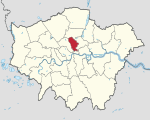St Mary's Church, Somers Town
1852 establishments in England19th-century Church of England church buildingsAnglo-Catholic church buildings in the London Borough of CamdenChurch of England church buildings in the London Borough of CamdenChurches completed in 1852 ... and 2 more
London church stubsUnited Kingdom Anglican church building stubs

St Mary's Church is a Church of England church behind Euston station on Eversholt Street in Somers Town, London Borough of Camden.
Excerpt from the Wikipedia article St Mary's Church, Somers Town (License: CC BY-SA 3.0, Authors, Images).St Mary's Church, Somers Town
Eversholt Street, London St Pancras (London Borough of Camden)
Geographical coordinates (GPS) Address External links Nearby Places Show on map
Geographical coordinates (GPS)
| Latitude | Longitude |
|---|---|
| N 51.531388888889 ° | E -0.13472222222222 ° |
Address
St Mary's
Eversholt Street
NW1 2DN London, St Pancras (London Borough of Camden)
England, United Kingdom
Open on Google Maps









